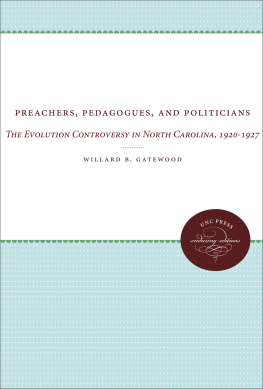Preface
In 1934, Dr. David Duncan Wallace published a four-volume History of South Carolina which has remained the most valuable study ever made of South Carolina, its people, and their institutions. During the 26 years that have elapsed since the appearance of Dr. Wallaces volumes, however, significant changes have taken place in South Carolina society, and scholars have uncovered much additional information about the states past. I therefore propose to give the general reader a brief, up-to-date survey of South Carolinas political, economic, educational, and religious development from 1865 to 1960. It is my hope that public-school and college students will also find this monograph useful.
As my chief emphasis is on political history, the first three chapters in the book deal primarily with the political story from 1865 to 1941. Next, there are three chapters devoted to industry and transportation, agriculture, and education and religion, tracing each of these topics chronologically within the 1865-1941 period. The following two chapters cover events from 1941 to 1960, and the final chapter contains a brief summary.
Except for the end of Reconstruction (1877), there was little significant break or change in South Carolina history from the end of the Civil War until the outbreak of World War II. Neither the advent of Benjamin R. Tillman nor the Spanish-American War, the coming of Coleman L. Blease nor World War I, produced any permanent or deep-seated change in South Carolinas one-party politics and cotton economy. Nor did South Carolinas educational and religious institutions, white or black, undergo any drastic innovations. Since 1941, however, the usual patterns of agriculture, industry, education, race relations, and even one-party politics have been greatly, and sometimes severely, altered. For this reason I have dealt with the 1941-60 years separately. Although my organization may be considered arbitrary, it has merit, I hope, in that any single chapter may be read as a separate essay.
In my footnotes I have acknowledged indebtedness to numerous persons who have written in the post-Civil-War period of South Carolina history. I am further indebted to many others. My fellow historians, Daniel W. Hollis of the University of South Carolina, and Carl L. Epting, Robert S. Lambert and Jack K. Williams of Clemson, read parts of the manuscript and offered valuable suggestions. My wife, Sarah Shirley Lander, aided me greatly on matters of style and spent endless hours proofreading. Thomas C. Witherspoon of the English Department at Clemson rendered editorial assistance, and Mrs. Vivian H. Lewis of Clemson typed the manuscript. I have learned much about South Carolinas past from my parents, Ernest Mc-Pherson and Kizzie Jones Lander. My father grew up in the piedmont, my mother in the lowcountry, and their lives have covered most of the years about which I have written. I also wish to express my appreciation to the Kress Foundation of Clemson College by whose financial assistance publication of this volume was made possible.
Chapter One
Reconstruction and Restitution of Home Rule, 1865-1877
There was probably no more trying period in South Carolinas history than the years 1865-77. The people were exhausted by the war, stunned by defeat, and overwhelmed by the political confusion arising out of the Reconstruction. Actually, the social, economic, and political changes that followed the war shook South Carolina to her depths.
Reconstruction fell into two periods: (1) Presidential Reconstruction, 1865-68, and (2) Radical Reconstruction, 1868-77. All 11 ex-Confederate states went through some form of Reconstruction. But only in South Carolina, Louisiana, and Florida did Reconstruction last until 1877. By contrast, Reconstruction in Virginia, North Carolina, and Tennessee was brief and not nearly so violent and tragic.
A. PRESIDENTIAL RECONSTRUCTION
1. Conditions in South Carolina at the End of the War
It is now impossible to grasp the magnitude of the terrible destruction inflicted on South Carolina by the war. Shermans army was the major destroyer of property. The Union forces literally burned their way across the state.
However, Sherman was not the only destroyer of property in South Carolina. Disastrous fires befell Charleston in 1861 and 1865, and Union warships bombarded the city a number of times. Shortly after the war John T. Trowbridge, a newspaper correspondent, described the city in this manner:
It has still many fine residences, built in a variety of style; but since those recent days of pride and prosperity, it has been woefully battered and desolated.... [Its] ruins are the most picturesque of any I saw in the South. The gardens and broken walls of many of its fine residences remain to attest their former elegance. Broad semi-circular flights of marble steps, leading up once to proud doorways, now conduct you over cracked and calcined slabs to the level of high foundations swept of everything but the crushed fragments of superstructures, with here and there a broken pillar, a windowless wall.
Trowbridge was also impressed with the numerous buzzards perched amid the ruins wherever garbage abounds.
Besides the wartime destruction, much South Carolina property suffered from neglect. This was particularly true of the farms and plantations. With their menfolk at the battlefront, the women did their best to keep the farms in operation. Frequently, the job was too great. As a consequence, terraces and dikes fell into disrepair, and flooding of lowlands and erosion of uplands occurred. Many flooded rice fields were never reclaimed for cultivation.
The states financial resources were exhausted. Nearly every patriotic Confederate had invested heavily in Confederate bonds. These bonds became worthless when General Lee surrendered. In addition to these financial losses, Union officials seized thousands of bales of cotton belonging to private citizens. The Union agents claimed that the cotton had been the property of the Confederate government, hence subject to lawful seizure.
These injuries were grievous, but South Carolinas greatest loss was her men who died in the war. Altogether, about 71,000 South Carolinians took part in the conflict. Of these, 12,922 died in action or later from battle wounds. No Northern state suffered a proportionately greater loss of manpower (on the basis of the size of its white population).
Finally, South Carolina underwent a great social and economic upheaval when its 400,000 slaves were set free. The suddenness of this freedom dazed both whites and blacks. The Negroes had little or no understanding of what freedom meant. They believed the Day of Jubilee had arrived. There would be no more work, no more worry, only singing and dancingso the majority thought.
Most Negroes, it is true, remained at their jobs on the plantations, but thousands wandered off to the cities or followed Union armies. Many Negroes caught contagious diseases due to improper food and unsanitary living conditions, while thousands of both races were in danger of starvation in the months immediately following the war.




